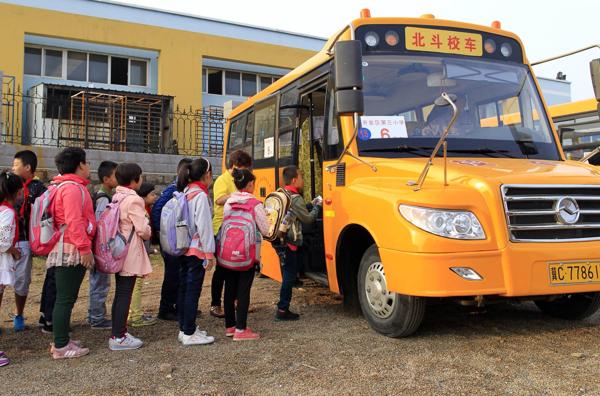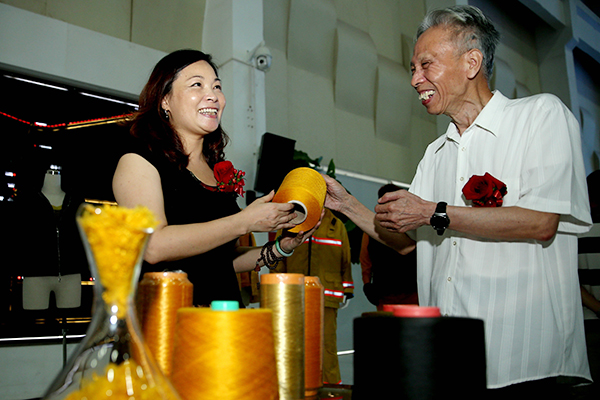
Students in Qinhuangdao, Hebei province, wait to get on a Beidou bus. The Beidou Navigation Satellite System has been used in many areas since it was put into operation in 2012. Its accuracy will reach 2.5 meters by 2020 and will provide services to many countries.[Photo by ZHU XINGXIN/CHINA DAILY]
Many of China’s leading defense companies are to be merged with commercial enterprises, as Peng Yining reports.
China is planning to accelerate the integration of State-owned defense contractors and private companies to boost the economy and strengthen the national defense system.
The program aims to build on the success of military-inspired innovations that have already found their way into civilian life. For example, China Shipbuilding Industry Corp, one of the country’s largest defense-sector enterprises, which took a leading role in the construction of the first Chinese-built aircraft, now also produces commercial yachts. Water-saving technology developed by China Aerospace Science and Technology Corp is now widely used in the agricultural sector, and the company’s Beidou navigation system is used to monitor forest fires and the movements of endangered animals in conservation areas.
China National Nuclear Corp, which is designated as being part of the defense industry, has used construction techniques it developed when building nuclear power stations to participate in major civilian construction projects, including the Bird’s Nest stadium which was built for the 2008 Beijing Olympic Games.
According to a recent report by the Ministry of Industry and Information Technology, 26 bases for civil and military industrial integration have been established, and 2 billion yuan ($327 million) has been invested in the project. The companies involved produced goods worth 1 trillion yuan in 2013.
“About 30 percent of military and civilian inventions could cross over into each other’s markets,” said Cao Zhiheng, inspector of the ministry’s Military-Civilian Promotion Department. “By 2020, China will have a full regulatory system to govern integration and to promote a healthy attitude toward sharing ideas and improving interaction between military and civil companies.”
Since the 1990s, China has been developing its economic strength and national defenses simultaneously, said Wang Shunian, director of the Department of Coordinated Economic and National Defense Development at the National Development and Reform Commission.
In 1999, China’s five main State-owned defense contractors were reorganized into 10 corporations that are allowed to operate under market conditions. That resulted in the value of goods produced by the military industrial sector falling by almost 50 percent, while the value of goods produced by commercial companies in the same field rose by 77 percent. Wang said the People’s Liberation Army has also opened a large number of airports, ports, railways, storage facilities, and communication bases to nonmilitary operators.
Mianyang, the second-largest city in the southwestern province of Sichuan, is one of the country’s most important bases for State-owned contractors, and home to 18 national research and development centers, including the China Academy of Engineering Physics and the China Aerodynamics Research and Development Center.
Between January and August, 33 fully integrated companies were established, bringing the number of such companies in Mianyang to 294. In the first eight months of this year, the value of the goods produced by the companies reached 91 billion yuan, 25 percent higher than in 2013, and total sales revenue was 93 billion yuan, a rise of 26 percent from a year ago.

Ding Mengxian (right), researcher at the Changchun Institute of Applied Chemistry, recommends a high-tech fiber to fashion designer Deng Zhaoping. Made of a special military material that was only used in areas such as supersonic aircraft and aerospace, the fiber will play a significant role in the development of China’s textile industry.[Photo by CHEN JIANLI/XINHUA]
With Mianyang as its main experimental area, China has been developing a greater number of military-to-civilian defense manufacturers and expanding their range of interests, according to Jiang Zhenghua, director of the Committee of the Military-Civilian Integration Research Center at the Academy of Military Sciences.
“President Xi Jinping supports the integration. He says it’s a national strategy with great influence on the country’s economic development and national security,” Jiang said. “We will definitely promote further integration in the future.”
China has also been cooperating with other countries to promote the program.
Volodymyr Korzhyk, a member of the Ukranian Academy of Sciences who has worked with Chinese scientists on military-to-civilian projects, said technology and materials developed for building battleships have been used in the production of nonmilitary vessels and high-speed railways.
“We’ve been working with China for more than 20 years and have a lot of experience at adapting military technology for civilian use,” he said.
Jacques S. Gansler, a former US undersecretary of defense, said both sides are likely to benefit from the integration of military and commercial operations. Because of the higher production volume of “dual use” products, integration will produce cheaper goods and services for both commercial and military uses, Gansler said in a speech in Mianyang in October.
Although commercial businesses usually deal in short-term, low-risk investments, the military sector is able to make long-term, high-risk investments in innovative technology. Under an integrated system, companies in the civilian sector will be allowed to take advantage of the huge sums invested in military research and development, but equally the military sector will also be able to take advantage of the even-larger sums that private companies invest in research and development.
“We can see that China is pushing integration faster than any other country,” Gansler added.
However, some experts are not so sanguine about the program’s prospects and have sounded a note of caution.
Du Xiangwan, a senior adviser at the Chinese Academy of Engineering Physics, said some inventions produced by State-owned contractors may take years, or even decades, to become established in the civilian market, but that doesn’t render the integration project worthless. Despite their genesis, many military-inspired innovations are perfect for use during peacetime.
“As warfare has become increasingly dependent on technology, a whole range of technologies has also become essential, and many of them have civilian applications,” he said. “Although the transfer process may not be smooth, it’s certainly worth attempting.”
Zhang Jun, a manager at Sichuan Changhong Electric Co, a consumer electronics company in Mianyang that started out making military radars in the 1950s but has grown to become China’s second-largest manufacturer of televisions, said integration may turn out to be a long and difficult process.
“The military-backed enterprises are used to working in a planned economy, so they lack extensive knowledge of life in competitive markets,” Zhang said. “They are not entirely comfortable when faced with competition, and there have been a number of communications problems and misunderstandings.
“For optimum efficiency, we start to work at 1 pm, but are often unable to contact our partners from the State-owned enterprises because they don’t start work until 2 pm,” he said. “We operate different systems, and have been unable to reach agreement even over a small issue like this. That means some attitudes and systems will need to change for integration to be successful.”
WARTIME NECESSITY DRIVES TECHNOLOGY
Throughout history, warfare has presented unique challenges that have prompted the development of new technologies. As far back as the Roman Empire, military necessity drove the rise of technology and innovations that have transcended their original applications, such as the Roman road system, which was originally built to facilitate the transport of troops, but civilians were the ultimate beneficiaries.
Five similar innovations:
1. The Internet: The earliest form of the Internet first saw the light of day in 1962, when the US Defense Department’s Advanced Research Projects Agency laid the groundwork of ARPANET, a revolutionary “packet-switching” (data communications) system and created a network of geographically separate computers that were able to exchange information.
2. Global Positioning System: GPS, also the brainchild of the US Defense Department, was first used in the 1970s to overcome the limitations of previous military navigation systems. Today, GPS provides secure, commercial channels for accurate navigation.
3. Duck, or duct, tape: During World War II, an adhesive tape was developed for use as a sealant for ammunition cases. Nicknamed “duck tape” because of its ability to repel water, the material was easy to tear into strips, making it quick and convenient to use. Following the war, the tape entered civilian use as a way of holding ducts together, and evolved from a brandless, green army tape to the familiar gray duct tape we know today.
4. Cryptography: Cryptography has a long history of military use, from Julius Caesar’s letter-shifting ciphers to the famous Enigma machine used to encode the Germany army’s communications during World War II. Now, with the assistance of highly developed mathematical theory and computer science, modern cryptography is the core of secure communications in banking, e-commerce, and many other applications.
5. Nursing: The foundations of professional nursing were laid by Florence Nightingale, a British nurse, during the Crimean War (1853-56). Subsequently, every major conflict prompted dramatic developments in the field, and the modern system of nursing employed in civilian hospitals across the world today evolved from the practices used in battlefield hospitals.
